High Frequency Neighborhood Trading - Part II
To give a clear idea of what can be found on the map and how to determine the location of the towers, let's move back to Howth.
[ first part ]
New York Stock Exchange [ English New York Stock Exchange, hereinafter NYSE ] In the United States at the moment is located in the city of Mahvah, in the state of New Jersey. For the local indigenous population, the people of Lenape, the word “makhvah” means “a place where paths intersect” - an ideal description of today's stock exchange.
')
On the NYSE, neighboring trading companies are located in the data center, and microwave radiation routes converge on the roof. The two main data centers in Europe are located in England, not far from London: the first is in the east in the city of Basildon with the NYSE equipment, which is owned by the Euronext Exchange [ former. LIFFE - the London International Financial Futures and Options Exchange ] and the Sigma X dark pool of Goldman Sacs; and the second is in the west in the city of Slough: this is the data center LD4, which includes exchanges managed by BATS [ Eng. Better Alternative Trading System ]. In Frankfurt, Germany, there is a data center Equinix FR2, whose services are used by Deutsche Börse and Eurex.
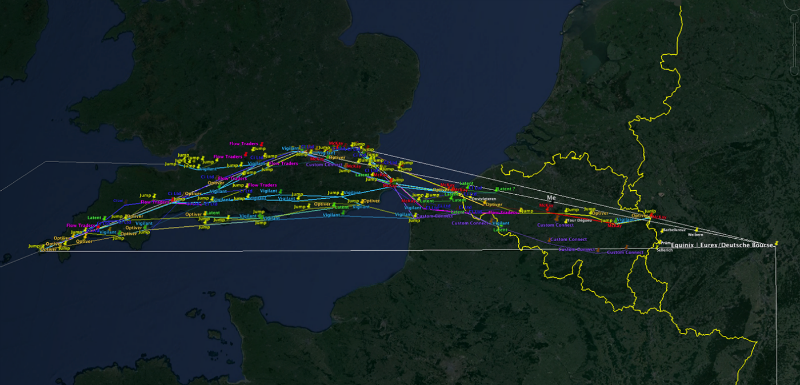
In the very limited world of microwave radiation, there are two types of competitors. The first type is HFT-companies engaged in prop-trading: located in Chicago, Jump Trading (known as World Class Wireless), the Dutch company Optiver and Flow Traders (known as Global Connect), and DRW (known as Vigilant Global). Some of these firms sell part of the frequency range to other customers. The second type is the popular providers: McKay Brothers , Custom Connect , as well as more recently NeXXcom and Latent Networks in Europe.
Their clients are banks, hedge funds, even other HFT companies. Some companies, like McKay Brothers, are only interested in the Frankfurt-London route ( ITinvest is working on providing access to the London Stock Exchange ), while others, Optiver, Flow Traders, Jump and Vigilant, are also connected to the cable-laying station Atlantic Crossing 1 in the Whitesand Band, Cornwall, England, which allows data to be transmitted across the Atlantic directly to Chicago using US radio-relay links. Let's start with Jump Trading.
Contrary to the generally accepted opinion, NATO did not use the tower at Houtem, advertised by Bloomberg, and did not own it; rather, the US Army built it for itself in the 1970s. The tower (as well as two more, located in Belgium, one of which is now in use by Jump) was sold to Belgium in 2006.
In 2012, the Minister of Finance of Belgium used the same savings in order to sell the tower at auction.
Bidding took place on December 18, 2012 in Verne. Despite the fact that the host of the auction is now retired, and my request for his phone number was rejected, I was able to talk to the person who visited the auction. There were only eight participants: the moderator, his assistant, a government official, and five potential buyers — two or three Americans, including a representative of Jump, one large Belgian law firm, perhaps acting on behalf of one of the competitors or being an ordinary listener.
Previously, each of the potential buyers directly visited the tower in Houtem, so everyone came to the auction, realizing that the tower was in poor condition, and its necessary repairs, according to my informant, would have cost the winner $ 1 million. The initial price was 255,000 euros, and the Belgian government would be happy to sell it for 400,000 euros. First, the price was raised by 5,000 euros, but after half an hour the price was 700,000 euros, respectively, increasing each time by 10,000 euros.
The presenter did not know who the buyers really were and why they showed such an interest in some old tower; this unexpectedly high price made him sweat a lot and ask for a break. Collecting his thoughts in the restroom, startled, he exhaled slowly: "What the hell ...". The auction resumed, bids rose to 1,000,000, 1,500,000, 2,000,000 euros. At this point, the presenter asked to take another pause. In the end, after three and a half hours, the tower was sold for 5,000,000 euros.
One of the participants quickly left the auction, as he parked near the police station, and the meter data grew. Another loser buyer approached the representative of Jump with the question “Maybe we can agree?”, Referring to the purchase of a part of the frequency range or the rental of space for an antenna on a tower in Houtem. It is a pity that at that moment I could not turn into a fly on the wall in order to confirm my suspicions about exactly which competitors tried to negotiate with Jump at an auction that day in Flanders.
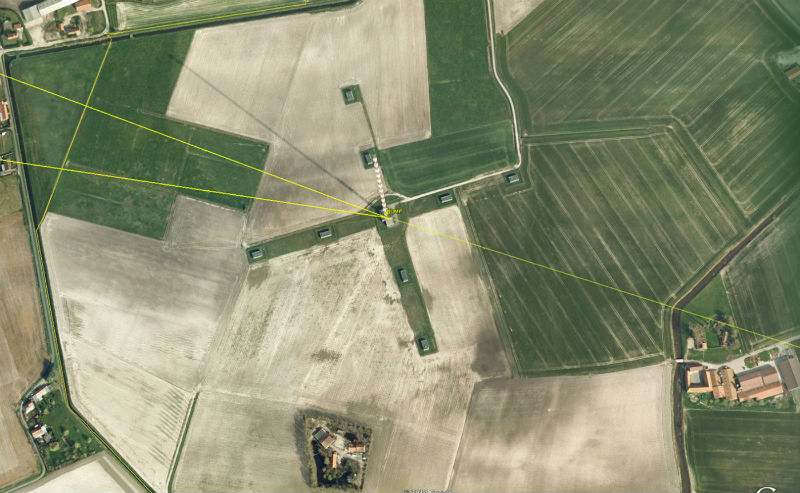
During the July holidays, I missed the tower, because of this I decided to return to Howm with my family in early September. I spoke with various people from the microwave industry, from Jump competitors to equipment suppliers, and they explained to me how to conduct an operational survey. I learned to act carefully, parked the car away from the tower, took binoculars and a camera, checked the GPS in the phone and then walked - I had to go, since most of the towers are in the potato fields.
Some trips to different towers allowed me to improve my strategy, so I gained confidence by moving closer to the desired object. In Houteme, I parked not far from the farm and walked along Chemin des Limites, near the French-Belgian border. Not far from the production facility, I noticed a van and a worker near the base of the tower. “Bad news,” I told myself, thinking that the National Security agent should always go unnoticed. I secretly began to shoot the Houtema tower:
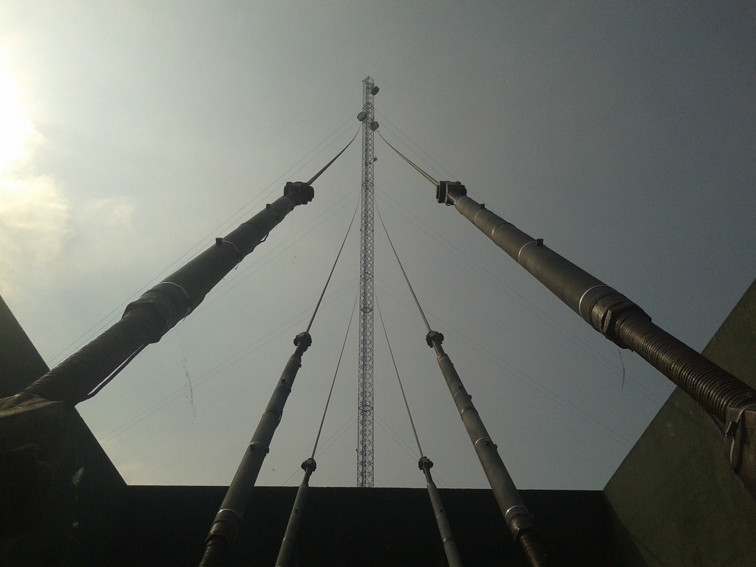
When the worker left to burn something in the field, I came closer:
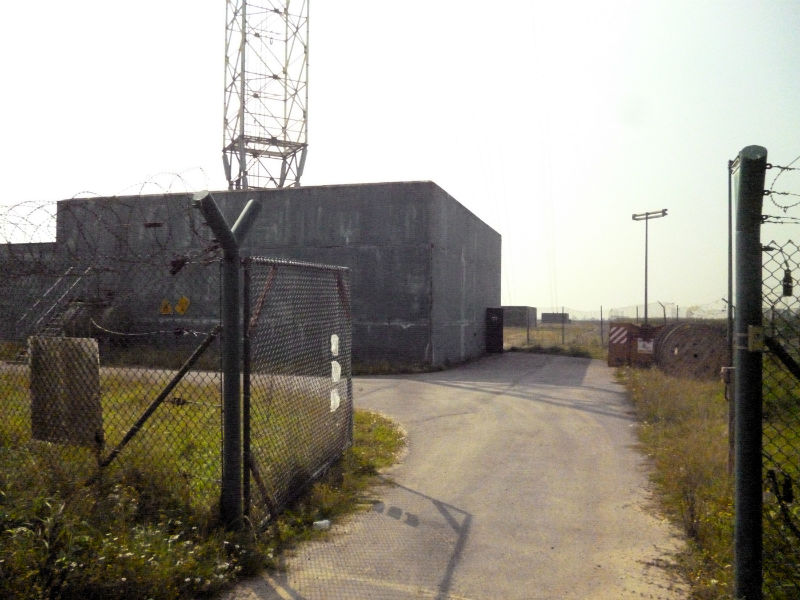
There was no “no trespassing” sign on the fence, so I naturally decided to use an unexpected opportunity - the employee left the doors open! My 63-year-old mother was standing on the shuher, watching the workers, while I went into each room, took photos of the equipment until I saw a large red button right in front of me, acting as an emergency shutdown button. It was amazing to realize that I could turn off the Jump's radio relay line by simply pressing a button. But I was not going to harm either Jump or Perseus's clients, and besides, there are fiber-optic isolation on the radio-relay communication lines, so any act of sabotage would be useless. I appeal to Jump lawyers: do not sue me. I know that I was in "private territory", so I am not going to upload my photos, although I saved this one:

It was amazing to see the incredibly small base of the 243-meter tower. This kind of towers - the wonders of technology. At this base diameter is only 25 centimeters, and the design remains in a vertical position only thanks to 48 stretch marks. Okay, I have to upload another photo, because the view is simply amazing:
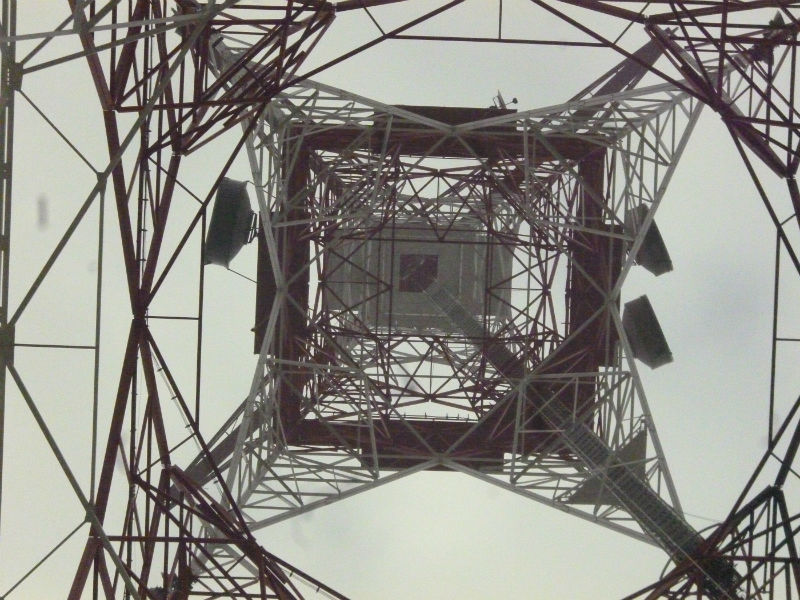
In general, more than cutting down electricity, I wanted to try to jump up and climb the tower, but the worker returned, so I quietly retired.
The tower was completely renovated and equipped from top to bottom with new stretch marks, but my goal was to test satellite dishes. At the time of the publication of the Bloomberg article, on the top of this tower there were two such antennas:

Three photos are visible on my photo, so Jump installed one more between the beginning of July and the beginning of September:

After that, I asked the same question that baffled the leading auction: Why? Why did Jump have to pay for the Houtema Tower? The first reason is height. High-frequency traders need high towers to ensure speed, and Houtemská tower is the fourth highest in Belgium. Below I have added to the table of the highest constructions from Wikipedia a column of names of HFT-companies owning towers:

Due to the fact that the US Army owned a tower in Houtem from 1974 to 2006, I found this document , published by the US Department of Commerce in 1979, entitled “Signal Level Distribution and Research in Regulation of a Radio Relay Line at 5 GHz "Manche." The article contained two graphics:
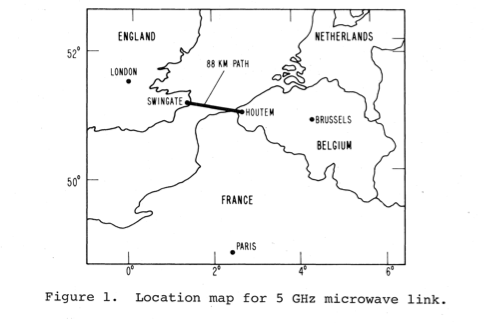
(By the way, Jump uses the frequency from 7.448400 to 7.48401 GHz for such a route of 87.8 km.)
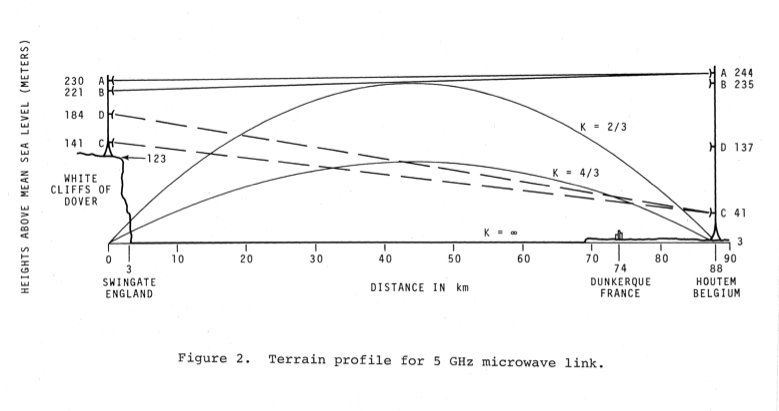
All competitors are forced to cross the English Channel on their way from France or Belgium to England. Mostly they are sent either to Swingate in the north of Dover, where there are two towers on which Optiver, McKay and Vigilant are located, or to Hougam in the south of Dover, where they installed their antennas Latent and Custom Connect:

The towers in Swingate are located on the famous white cliffs of Dover, at an altitude of approximately 141 meters above sea level. However, some competitors of high-frequency traders create a link from Swingate to Dunkirk, a city located above sea level.
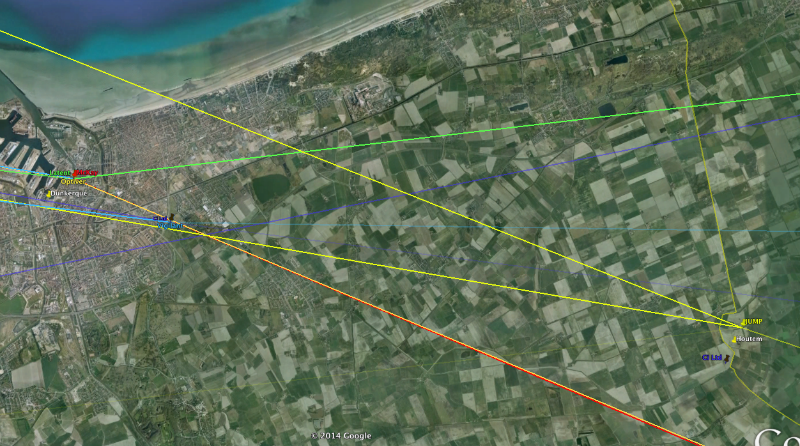
In Dunkirk, antennas were installed on the Tour du Reuze tower:
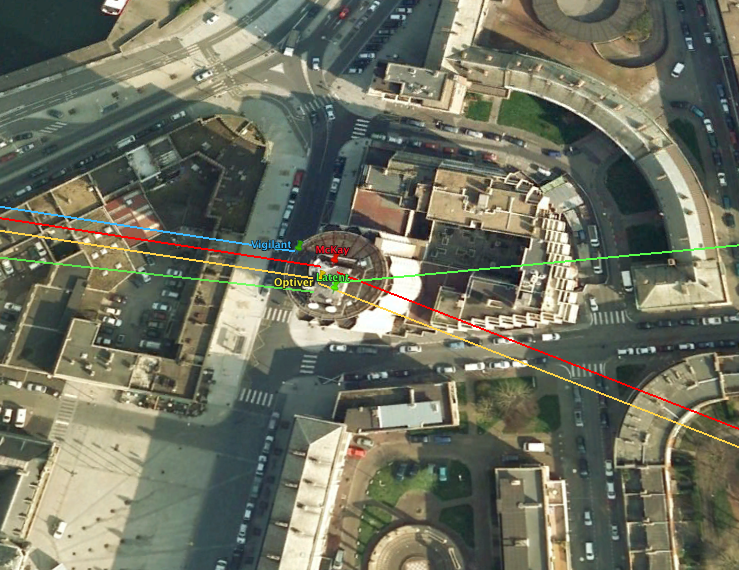
In fairness, we’ll come back and correct the schedule of the US Department of Commerce:

Without going too far into physics, I would say that microwave links do not move in a straight line. Depending on atmospheric conditions, they deviate to a greater or lesser degree, mainly downwards. Thus, in order to reach the tower, the signal must travel a distance longer than that which corresponds to the positions of Euclidean geometry . The Jump tower offers only a limited advantage, because the additional path is proportional to the square root of its height, while the price of the tower is directly proportional to its height and even more. I did not find anyone who would understand why Jump paid such a high price for it.
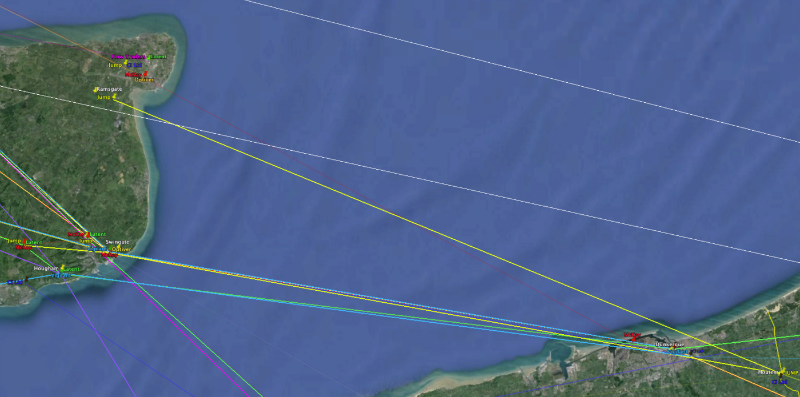
Jump, among other things, use other towers in Belgium. The Belgian radio regulatory authorities clearly lack openness, but I found one , second , third, and then a fourth dossier, which allows me to connect some routes:
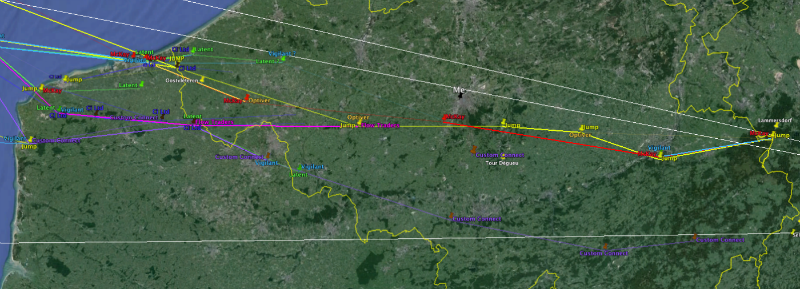
On Flabeck, another old US Army tower, they camped with Flow Traders and Optiver:
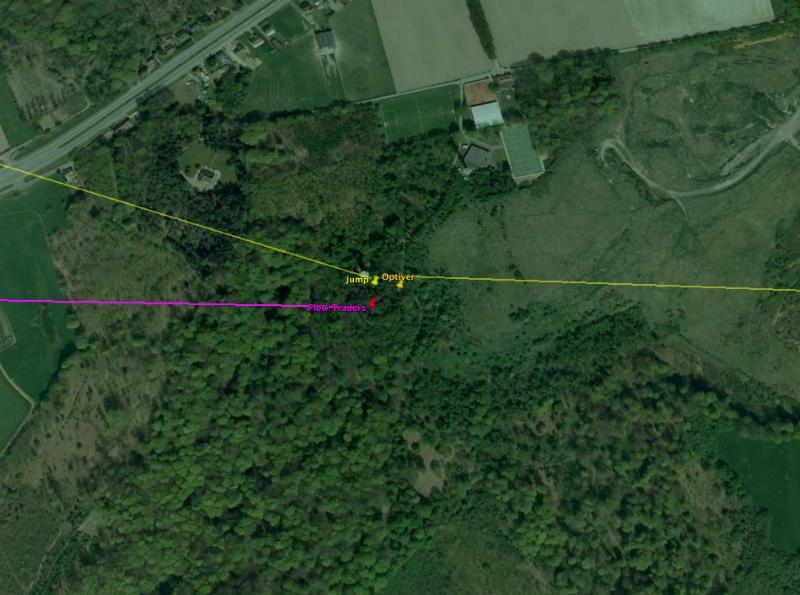
In Hannute, they only collaborate with Optiver. Comparing these two documents, it turns out that Jump installed a third antenna in Hannuty between February 2012 and February 2013, possibly after they acquired the tower in Houtem. In Liege, Jump on the tower alone, although Vigilant and McKay are within a radius of 1.07 kilometers:

I visited another tower, where Jump is located, in Wavre, near Brussels. The Wavre tower is the third highest construction in Belgium. As usual, I parked the car far from the tower and walked through the fields. Several technicians worked on the top of the 250-meter tower, but from my vantage point on earth they looked tiny. Unlike the Houtemsky tower, which required stretching to maintain the vertical state, the tower in Wavre is an excellent “standing structure”:
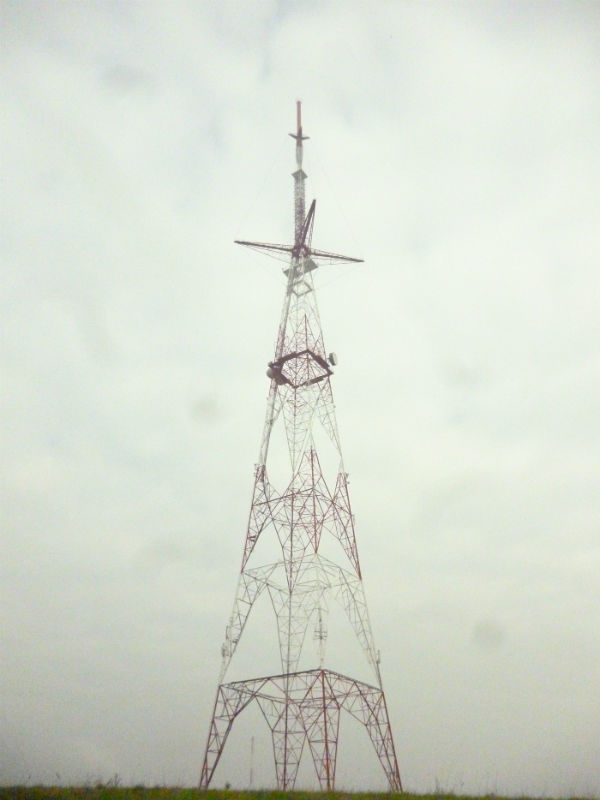
Wavre is also known to fans of extreme sports called BASE jumping. Here you can see two crazy people jumping from the tower: I hope they didn’t damage the antennas while they were flying:
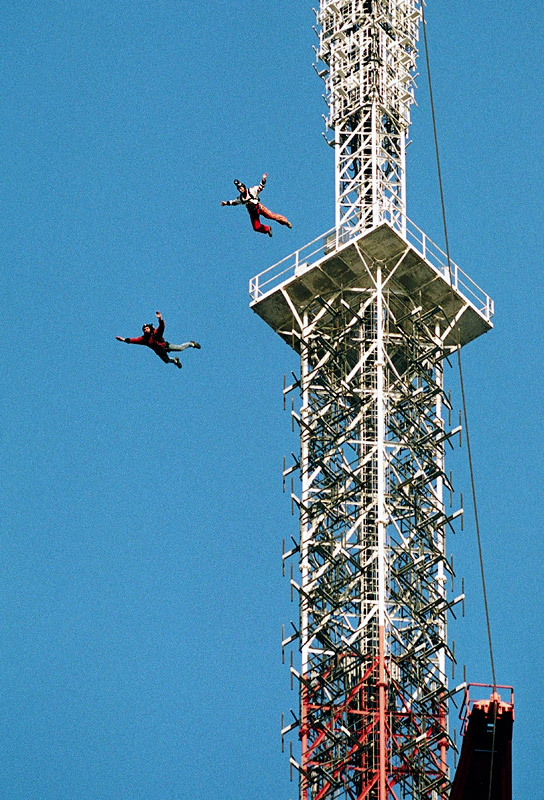
The reason for my trip to the tower in Wavre was the sabotage that occurred last spring and became an important event in Belgium. On the morning of May 24, 2014, several people organized the arson and thereby caused significant damage to the tower - this video (in French) shows the burned parts of the antennas. The tower is owned by the Belgian national television and radio operator RTBF, and also contains several antennas used by mobile operators. The arson attracted so much media attention because May 24 was an important election day for Belgium. RTBF quickly built a temporary tower to install mobile, television and radio operators antennas on it, but Jump antennas remained on the main tower, since the 50-meter temporary tower was not high enough for them.
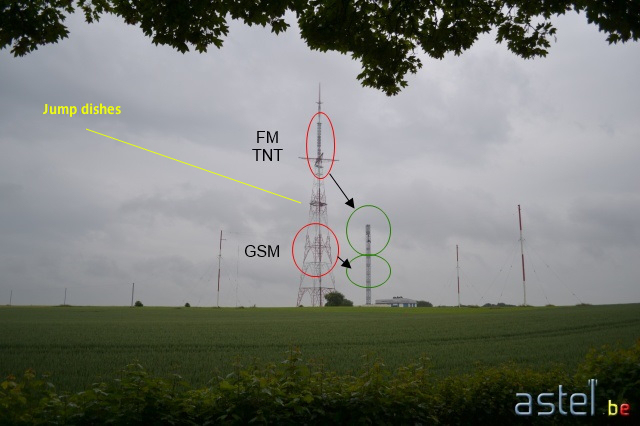
During my visit to Wavre, you could see some of the burned parts on the ground:

Of course, all the burned cables brought the Jump lines to a non-working state for a while. It is curious whether the police questioned any of Jump’s competitors or those who knew that the trading company was on a tower in Wavre. If at the beginning of September all cables were replaced with new ones, then the Jump lines must be in good condition. Below are shown three large jump antennas, two directed towards Hannut, the third towards Flaotek or Ost-Leteren:

I would like to know whether Jump, Optiver, and especially Vigilant, really used the routes between New Haven and Isle of Wight:

A competitor Jump, who asked, “Maybe we can reach an agreement?” At the auction, may not have asked to install antennas on the tower; surely his proposal was to divide the frequency range. Despite the fact that in a small world of financial radio-relay communication lines as calmly as in the potato fields where their towers are located, I found that Jump shares its lines of communication with Perseus and another provider whose name I am forbidden to name. The facts are:
Now imagine that each customer in the service sends data almost at the same time: this is a very likely scenario, because the probability of a situation in which one customer sends its data just a few nano or microseconds before the other, and so on, is extremely high. In this thought experiment, Client 1, first, needs 6 microseconds to switch to a microwave link at 100 Mb / s. Client 2 sends its trading data after 2 microseconds, so it waits 4 microseconds before the transition and for 6 microseconds, it actually goes to the communication line. Client 3 sends commercial data 1 microsecond after Client 2, waiting for 3 microseconds for Client 1, then 6 microseconds for Client 2, and another 6 microseconds to go to the communication line. Client 4 is faster: it sends data after 1 nanosecond after Client 3. And waits for 2.999 microseconds of Client 1, then 6 - Client 2, the same amount - Client 3, and another 6 microseconds, actually, switching to the communication line.
This example shows the superiority of the network owner in terms of speed with an agreement on a divided frequency range. Jump shares its range with Perseus. Since Perseus has its customers, none of them will be as fast as Jump. However, this does not mean that Jump is the fastest operator in the world of high-frequency trading. Although they have acquired a high tower in a favorable place, nevertheless, they are not as quick as their rivals, for example ... well, let's talk about faster high-frequency traders in Part III.
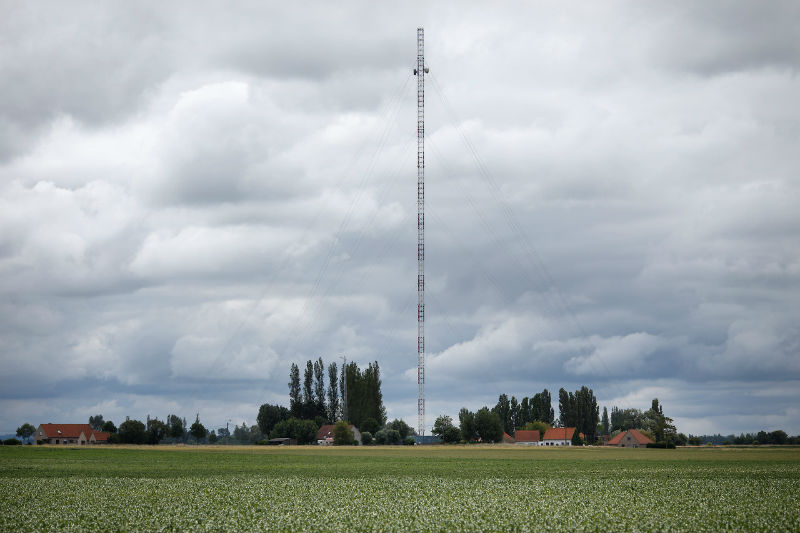
To be continued…
PS If you notice a typo, mistake or inaccuracy of the translation - write a personal message and we will fix everything promptly.
[ first part ]
From Frankfurt to London ... and Chicago
New York Stock Exchange [ English New York Stock Exchange, hereinafter NYSE ] In the United States at the moment is located in the city of Mahvah, in the state of New Jersey. For the local indigenous population, the people of Lenape, the word “makhvah” means “a place where paths intersect” - an ideal description of today's stock exchange.
')
On the NYSE, neighboring trading companies are located in the data center, and microwave radiation routes converge on the roof. The two main data centers in Europe are located in England, not far from London: the first is in the east in the city of Basildon with the NYSE equipment, which is owned by the Euronext Exchange [ former. LIFFE - the London International Financial Futures and Options Exchange ] and the Sigma X dark pool of Goldman Sacs; and the second is in the west in the city of Slough: this is the data center LD4, which includes exchanges managed by BATS [ Eng. Better Alternative Trading System ]. In Frankfurt, Germany, there is a data center Equinix FR2, whose services are used by Deutsche Börse and Eurex.

In the very limited world of microwave radiation, there are two types of competitors. The first type is HFT-companies engaged in prop-trading: located in Chicago, Jump Trading (known as World Class Wireless), the Dutch company Optiver and Flow Traders (known as Global Connect), and DRW (known as Vigilant Global). Some of these firms sell part of the frequency range to other customers. The second type is the popular providers: McKay Brothers , Custom Connect , as well as more recently NeXXcom and Latent Networks in Europe.
Their clients are banks, hedge funds, even other HFT companies. Some companies, like McKay Brothers, are only interested in the Frankfurt-London route ( ITinvest is working on providing access to the London Stock Exchange ), while others, Optiver, Flow Traders, Jump and Vigilant, are also connected to the cable-laying station Atlantic Crossing 1 in the Whitesand Band, Cornwall, England, which allows data to be transmitted across the Atlantic directly to Chicago using US radio-relay links. Let's start with Jump Trading.
Incredible bidding at auction
Contrary to the generally accepted opinion, NATO did not use the tower at Houtem, advertised by Bloomberg, and did not own it; rather, the US Army built it for itself in the 1970s. The tower (as well as two more, located in Belgium, one of which is now in use by Jump) was sold to Belgium in 2006.
“The Ministry of Defense today announced the decision to deactivate and return the three sites of Belgium's relay stations. (...) Closing these sites will result in annual savings estimated at more than $ 84,000, according to a comparison of current annual operations and maintenance costs with the cost of replacing commercial communications, ”wrote the US Department of Defense.
In 2012, the Minister of Finance of Belgium used the same savings in order to sell the tower at auction.
Bidding took place on December 18, 2012 in Verne. Despite the fact that the host of the auction is now retired, and my request for his phone number was rejected, I was able to talk to the person who visited the auction. There were only eight participants: the moderator, his assistant, a government official, and five potential buyers — two or three Americans, including a representative of Jump, one large Belgian law firm, perhaps acting on behalf of one of the competitors or being an ordinary listener.
Previously, each of the potential buyers directly visited the tower in Houtem, so everyone came to the auction, realizing that the tower was in poor condition, and its necessary repairs, according to my informant, would have cost the winner $ 1 million. The initial price was 255,000 euros, and the Belgian government would be happy to sell it for 400,000 euros. First, the price was raised by 5,000 euros, but after half an hour the price was 700,000 euros, respectively, increasing each time by 10,000 euros.
The presenter did not know who the buyers really were and why they showed such an interest in some old tower; this unexpectedly high price made him sweat a lot and ask for a break. Collecting his thoughts in the restroom, startled, he exhaled slowly: "What the hell ...". The auction resumed, bids rose to 1,000,000, 1,500,000, 2,000,000 euros. At this point, the presenter asked to take another pause. In the end, after three and a half hours, the tower was sold for 5,000,000 euros.
One of the participants quickly left the auction, as he parked near the police station, and the meter data grew. Another loser buyer approached the representative of Jump with the question “Maybe we can agree?”, Referring to the purchase of a part of the frequency range or the rental of space for an antenna on a tower in Houtem. It is a pity that at that moment I could not turn into a fly on the wall in order to confirm my suspicions about exactly which competitors tried to negotiate with Jump at an auction that day in Flanders.
Mad visit to the tower in Howm

During the July holidays, I missed the tower, because of this I decided to return to Howm with my family in early September. I spoke with various people from the microwave industry, from Jump competitors to equipment suppliers, and they explained to me how to conduct an operational survey. I learned to act carefully, parked the car away from the tower, took binoculars and a camera, checked the GPS in the phone and then walked - I had to go, since most of the towers are in the potato fields.
Some trips to different towers allowed me to improve my strategy, so I gained confidence by moving closer to the desired object. In Houteme, I parked not far from the farm and walked along Chemin des Limites, near the French-Belgian border. Not far from the production facility, I noticed a van and a worker near the base of the tower. “Bad news,” I told myself, thinking that the National Security agent should always go unnoticed. I secretly began to shoot the Houtema tower:

When the worker left to burn something in the field, I came closer:

There was no “no trespassing” sign on the fence, so I naturally decided to use an unexpected opportunity - the employee left the doors open! My 63-year-old mother was standing on the shuher, watching the workers, while I went into each room, took photos of the equipment until I saw a large red button right in front of me, acting as an emergency shutdown button. It was amazing to realize that I could turn off the Jump's radio relay line by simply pressing a button. But I was not going to harm either Jump or Perseus's clients, and besides, there are fiber-optic isolation on the radio-relay communication lines, so any act of sabotage would be useless. I appeal to Jump lawyers: do not sue me. I know that I was in "private territory", so I am not going to upload my photos, although I saved this one:

It was amazing to see the incredibly small base of the 243-meter tower. This kind of towers - the wonders of technology. At this base diameter is only 25 centimeters, and the design remains in a vertical position only thanks to 48 stretch marks. Okay, I have to upload another photo, because the view is simply amazing:

In general, more than cutting down electricity, I wanted to try to jump up and climb the tower, but the worker returned, so I quietly retired.
The tower was completely renovated and equipped from top to bottom with new stretch marks, but my goal was to test satellite dishes. At the time of the publication of the Bloomberg article, on the top of this tower there were two such antennas:

Three photos are visible on my photo, so Jump installed one more between the beginning of July and the beginning of September:

After that, I asked the same question that baffled the leading auction: Why? Why did Jump have to pay for the Houtema Tower? The first reason is height. High-frequency traders need high towers to ensure speed, and Houtemská tower is the fourth highest in Belgium. Below I have added to the table of the highest constructions from Wikipedia a column of names of HFT-companies owning towers:

Due to the fact that the US Army owned a tower in Houtem from 1974 to 2006, I found this document , published by the US Department of Commerce in 1979, entitled “Signal Level Distribution and Research in Regulation of a Radio Relay Line at 5 GHz "Manche." The article contained two graphics:

(By the way, Jump uses the frequency from 7.448400 to 7.48401 GHz for such a route of 87.8 km.)

All competitors are forced to cross the English Channel on their way from France or Belgium to England. Mostly they are sent either to Swingate in the north of Dover, where there are two towers on which Optiver, McKay and Vigilant are located, or to Hougam in the south of Dover, where they installed their antennas Latent and Custom Connect:

The towers in Swingate are located on the famous white cliffs of Dover, at an altitude of approximately 141 meters above sea level. However, some competitors of high-frequency traders create a link from Swingate to Dunkirk, a city located above sea level.

In Dunkirk, antennas were installed on the Tour du Reuze tower:

In fairness, we’ll come back and correct the schedule of the US Department of Commerce:

Without going too far into physics, I would say that microwave links do not move in a straight line. Depending on atmospheric conditions, they deviate to a greater or lesser degree, mainly downwards. Thus, in order to reach the tower, the signal must travel a distance longer than that which corresponds to the positions of Euclidean geometry . The Jump tower offers only a limited advantage, because the additional path is proportional to the square root of its height, while the price of the tower is directly proportional to its height and even more. I did not find anyone who would understand why Jump paid such a high price for it.

Wavre Tower
Jump, among other things, use other towers in Belgium. The Belgian radio regulatory authorities clearly lack openness, but I found one , second , third, and then a fourth dossier, which allows me to connect some routes:

On Flabeck, another old US Army tower, they camped with Flow Traders and Optiver:

In Hannute, they only collaborate with Optiver. Comparing these two documents, it turns out that Jump installed a third antenna in Hannuty between February 2012 and February 2013, possibly after they acquired the tower in Houtem. In Liege, Jump on the tower alone, although Vigilant and McKay are within a radius of 1.07 kilometers:

I visited another tower, where Jump is located, in Wavre, near Brussels. The Wavre tower is the third highest construction in Belgium. As usual, I parked the car far from the tower and walked through the fields. Several technicians worked on the top of the 250-meter tower, but from my vantage point on earth they looked tiny. Unlike the Houtemsky tower, which required stretching to maintain the vertical state, the tower in Wavre is an excellent “standing structure”:

Wavre is also known to fans of extreme sports called BASE jumping. Here you can see two crazy people jumping from the tower: I hope they didn’t damage the antennas while they were flying:

The reason for my trip to the tower in Wavre was the sabotage that occurred last spring and became an important event in Belgium. On the morning of May 24, 2014, several people organized the arson and thereby caused significant damage to the tower - this video (in French) shows the burned parts of the antennas. The tower is owned by the Belgian national television and radio operator RTBF, and also contains several antennas used by mobile operators. The arson attracted so much media attention because May 24 was an important election day for Belgium. RTBF quickly built a temporary tower to install mobile, television and radio operators antennas on it, but Jump antennas remained on the main tower, since the 50-meter temporary tower was not high enough for them.

During my visit to Wavre, you could see some of the burned parts on the ground:

Of course, all the burned cables brought the Jump lines to a non-working state for a while. It is curious whether the police questioned any of Jump’s competitors or those who knew that the trading company was on a tower in Wavre. If at the beginning of September all cables were replaced with new ones, then the Jump lines must be in good condition. Below are shown three large jump antennas, two directed towards Hannut, the third towards Flaotek or Ost-Leteren:

Height and speed
I would like to know whether Jump, Optiver, and especially Vigilant, really used the routes between New Haven and Isle of Wight:

A competitor Jump, who asked, “Maybe we can reach an agreement?” At the auction, may not have asked to install antennas on the tower; surely his proposal was to divide the frequency range. Despite the fact that in a small world of financial radio-relay communication lines as calmly as in the potato fields where their towers are located, I found that Jump shares its lines of communication with Perseus and another provider whose name I am forbidden to name. The facts are:
- The microwave communication line can be divided into parts, in each of which the transmission speed will be no more than 10 Mb / s.
- In general, the microwave link will have a transfer rate of 100 Mb / s. Transmission of each packet to 64 bytes on these lines will take 6 microseconds - the time interval may change with a different form of transmission.
- Each participant sends fragments of trading data to 64 bytes for service.
- With a bandwidth of 10 Mb / s, customers can only send 1 packet about every 60 microseconds.
Now imagine that each customer in the service sends data almost at the same time: this is a very likely scenario, because the probability of a situation in which one customer sends its data just a few nano or microseconds before the other, and so on, is extremely high. In this thought experiment, Client 1, first, needs 6 microseconds to switch to a microwave link at 100 Mb / s. Client 2 sends its trading data after 2 microseconds, so it waits 4 microseconds before the transition and for 6 microseconds, it actually goes to the communication line. Client 3 sends commercial data 1 microsecond after Client 2, waiting for 3 microseconds for Client 1, then 6 microseconds for Client 2, and another 6 microseconds to go to the communication line. Client 4 is faster: it sends data after 1 nanosecond after Client 3. And waits for 2.999 microseconds of Client 1, then 6 - Client 2, the same amount - Client 3, and another 6 microseconds, actually, switching to the communication line.
This example shows the superiority of the network owner in terms of speed with an agreement on a divided frequency range. Jump shares its range with Perseus. Since Perseus has its customers, none of them will be as fast as Jump. However, this does not mean that Jump is the fastest operator in the world of high-frequency trading. Although they have acquired a high tower in a favorable place, nevertheless, they are not as quick as their rivals, for example ... well, let's talk about faster high-frequency traders in Part III.

To be continued…
PS If you notice a typo, mistake or inaccuracy of the translation - write a personal message and we will fix everything promptly.
Source: https://habr.com/ru/post/243873/
All Articles